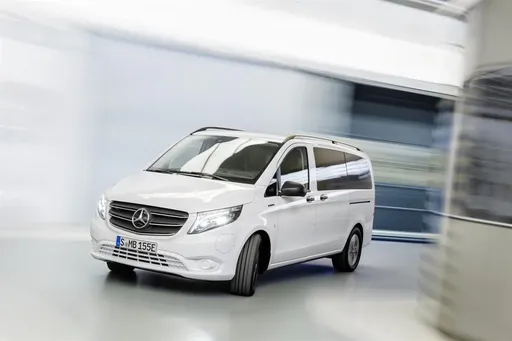Mercedes Vito Bus vs Renault Master Bus – Differences & prices compared
Two cars, one duel: Mercedes Vito Bus meets Renault Master Bus.
Which one wins in performance, efficiency and value for money? Find out now!
Costs and Efficiency:
When it comes to price and running costs, the biggest differences usually appear. This is often where you see which car fits your budget better in the long run.
Mercedes Vito Bus has a slight advantage in terms of price – it starts at 36300 £, while the Renault Master Bus costs 36600 £. That’s a price difference of around 257 £.
Fuel consumption also shows a difference: Mercedes Vito Bus manages with 6.70 L and is therefore evident more efficient than the Renault Master Bus with 8.70 L. The difference is about 2 L per 100 km.
Engine and Performance:
Power, torque and acceleration are the classic benchmarks for car enthusiasts – and here, some clear differences start to show.
When it comes to engine power, the Mercedes Vito Bus has a clearly perceptible edge – offering 237 HP compared to 180 HP. That’s roughly 57 HP more horsepower.
In terms of top speed, the Renault Master Bus performs somewhat better – reaching 165 km/h, while the Mercedes Vito Bus tops out at 140 km/h. The difference is around 25 km/h.
There’s also a difference in torque: Mercedes Vito Bus pulls somewhat stronger with 500 Nm compared to 400 Nm. That’s about 100 Nm difference.
Space and Everyday Use:
Cabin size, boot volume and payload all play a role in everyday practicality. Here, comfort and flexibility make the difference.
Seats: Renault Master Bus offers slightly more seating capacity – 9 vs 8.
In curb weight, Mercedes Vito Bus is hardly perceptible lighter – 2023 kg compared to 2189 kg. The difference is around 166 kg.
In maximum load capacity, the Mercedes Vito Bus performs slight better – up to 4990 L, which is about 150 L more than the Renault Master Bus.
When it comes to payload, Renault Master Bus to a small extent takes the win – 1254 kg compared to 1077 kg. That’s a difference of about 177 kg.
Who comes out on top?
Overall, the Mercedes Vito Bus shows itself to be shows small but notable strengths and secures the title of DriveDuel Champion.
It convinces with the more balanced overall package and proves to be the more versatile choice for everyday use.

Mercedes Vito Bus
Mercedes Vito Bus
The Mercedes-Benz Vito Bus offers a versatile solution for those in need of spacious and comfortable group transportation. Its refined interior is designed to enhance passenger comfort, making it ideal for both business and leisure travel. With a focus on safety and efficiency, it provides a reliable driving experience that aligns with the high standards expected of the Mercedes-Benz brand.
details
Renault Master Bus
The Renault Master Bus offers a spacious and flexible interior, making it an excellent choice for transporting groups comfortably. It features a robust design and advanced safety systems, ensuring a secure ride for all passengers. With its efficient diesel engine, the Master Bus combines power with impressive fuel economy, appealing to both businesses and private users alike.
details

|
|
|
|
|
Costs and Consumption |
|
|---|---|
|
Price
36300 - 55900 £
|
Price
36600 - 43200 £
|
|
Consumption L/100km
6.7 - 10 L
|
Consumption L/100km
8.7 - 10.7 L
|
|
Consumption kWh/100km
26.7 - 26.9 kWh
|
Consumption kWh/100km
-
|
|
Electric Range
248 - 370 km
|
Electric Range
-
|
|
Battery Capacity
60 - 90 kWh
|
Battery Capacity
-
|
|
co2
0 - 228 g/km
|
co2
227 - 280 g/km
|
|
Fuel tank capacity
57 - 70 L
|
Fuel tank capacity
105 L
|
Dimensions and Body |
|
|---|---|
|
Body Type
Bus
|
Body Type
Bus
|
|
Seats
8
|
Seats
6 - 9
|
|
Doors
4
|
Doors
4
|
|
Curb weight
2023 - 2739 kg
|
Curb weight
2189 - 2361 kg
|
|
Trunk capacity
580 - 1390 L
|
Trunk capacity
-
|
|
Length
4895 - 5370 mm
|
Length
5075 - 5575 mm
|
|
Width
1928 mm
|
Width
2070 mm
|
|
Height
1890 mm
|
Height
2290 - 2486 mm
|
|
Max trunk capacity
4190 - 4990 L
|
Max trunk capacity
2840 - 4840 L
|
|
Payload
726 - 1077 kg
|
Payload
939 - 1254 kg
|
Engine and Performance |
|
|---|---|
|
Engine Type
Diesel, Electric, Petrol
|
Engine Type
Diesel
|
|
Transmission
Automatic
|
Transmission
Manuel, Automatic
|
|
Transmission Detail
Automatic Gearbox, Reduction Gearbox
|
Transmission Detail
Manual Gearbox, Automated Manual
|
|
Drive Type
Rear-Wheel Drive, All-Wheel Drive, Front-Wheel Drive
|
Drive Type
Front-Wheel Drive
|
|
Power HP
136 - 237 HP
|
Power HP
135 - 180 HP
|
|
Acceleration 0-100km/h
-
|
Acceleration 0-100km/h
-
|
|
Max Speed
140 km/h
|
Max Speed
150 - 165 km/h
|
|
Torque
330 - 500 Nm
|
Torque
360 - 400 Nm
|
|
Number of Cylinders
4
|
Number of Cylinders
4
|
|
Power kW
100 - 174 kW
|
Power kW
99 - 132 kW
|
|
Engine capacity
1950 - 1999 cm3
|
Engine capacity
2299 cm3
|
General |
|
|---|---|
|
Model Year
2024
|
Model Year
2023
|
|
CO2 Efficiency Class
G, A
|
CO2 Efficiency Class
G
|
|
Brand
Mercedes-Benz
|
Brand
Renault
|
What drive types are available for the Mercedes Vito Bus?
The Mercedes Vito Bus is offered with Rear-Wheel Drive, All-Wheel Drive or Front-Wheel Drive.
The prices and data displayed are estimates based on German list prices and may vary by country. This information is not legally binding.
